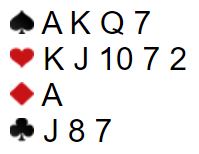Make sure you discuss this situation with partner when filling out your convention card. Here is what that portion of convention card looks like:
Hilo Bridge Club Updates
I discovered new slam bidding insights when kibitzing this hand recently on BBO. East-West were world-class players Robert Levin and Geoff Hampson.
East forced to game in spades with his Jacoby 2NT response. His hand was too good to make a splinter response of four clubs.
When East next asked about kings, West denied having any by jumping to six spades (East already knew about the king of spades from the RKCB inquiry). Eye opening slam bidding by EW.
*25 Conventions You Should Know by Barbara Seagram and Marc Smith, p. 86. Entire book is highly recommend: https://www.amazon.com/Bridge-Conventions-You-Should-Know/dp/189415407X
FYI nicesummary of RKCB http://web2.acbl.org/documentLibrary/play/Commonly_Used_Conventions/romankeycard.pdf
Levin also demonstrated how to play this well-bid hand. Here is his puzzle for you: How did Levin hold his heart losers to one after lead of a low diamond by North? I will get to that tomorrow.
The control-showing cuebid was the single most significant advance in bidding theory ever made, and is far more useful for accurate slam bidding than Blackwood* can ever be.
*I would add Roman Keycard Blackwood as well.
This is from 25 Conventions You Should Know by Barbara Seagram and Marc Smith. Use cuebids whenever possible.
In this case your partner opens the bidding with one diamond. Right hand opponent overcalls one heart, You hold:
You have just enought strength to make a negative double with bidding still at the one level. Double by you says to partner that you hold exactly four spades and 6+points. If you held 5+ spades you would instead bid one spade.
Here is a hand from yesterday that displayed the negative double in action.
Your partner opens one diamond in second seat. Right hand opponent overcalls one spade. You have some nice values, four hearts and six clubs. It’s perfect situation for a negative double. Double promises four plus hearts in this situation. Your partner will know what to do. Most pairs yesterday got to game and made five hearts.
My partner opened the bidding one heart in 2nd seat. I held this hand as responder:
I really like my hand. I want us to end up in at least four hearts. Partner may be able to bring home five spade tricks from dummy. I responded one spade. Partner’s rebid was two diamonds. My rebid was three clubs (4th suit forcing to game).
Partner next bid three diamonds, so I know that she is at least 5-5 in the red suits. I bid three hearts, setting hearts at the trump suit, and partner raised to four hearts.
This is where I went off the rails. I should not have been so anxious to use my new cue-bidding-to-slam tool. Too many warning signs: misfit in diamonds, no second-round control in clubs, none of the top four honors in hearts, no extras shown by partner in the auction.
Undeterred, I foolishly cue bid four spades, showing first round control. Of course, we got too high and missed our easy game. Sorry for falling in love with my hand, partner.
Your right-hand opponent deals and opens the bidding one heart. What do you say with this hand?
Start by evaluating your hand. Your queen of spades is worth two points, since it’s bolstered nicely by the 10, 9, 7. Your heart king can be promoted, since opener will have the ace 75 percent of the time. You have a nice seven points in diamonds and a crummy one point in clubs. That gives you a hand worth a good 13 points. Compete when you have the strength and shape for a takeout double.
Double, hoping to find your partner with a spade suit. But you also have support for the minors if need be.
